The Way It Is/ Eight key men in Penske Racing's historyby Gordon Kirby |
 As Penske Racing celebrates its 50th anniversary it's worth taking a look at some of the key men in the background who helped propel the team to its heights of success. In writing and researching my upcoming new book 'Penske's Maestro, Karl Kainhofer & the History of Penske Racing' I had the pleasure of talking to many people who worked for Penske over the years. This week I'm going to take a brief look at eight men who played key roles along with Kainhofer in the creation and development of Penske Racing.
As Penske Racing celebrates its 50th anniversary it's worth taking a look at some of the key men in the background who helped propel the team to its heights of success. In writing and researching my upcoming new book 'Penske's Maestro, Karl Kainhofer & the History of Penske Racing' I had the pleasure of talking to many people who worked for Penske over the years. This week I'm going to take a brief look at eight men who played key roles along with Kainhofer in the creation and development of Penske Racing.
The first of these was Leroy Gane who took care of Penske's Birdcage Maserati, Cooper Monaco and Cooper F1 car in 1960 and '61. He also built Penske's renowned Zerex Special in 1962 and was crew chief on Mark Donohue's Trans-Am championship winning Camaros in 1967 and '68. Gane also helped Karl from time to time in preparing various Penske cars through the team's early years. "Over the years Karl and I worked together on a lot of stuff," Gane remarks. "We didn't get paid by the hour. We were paid a salary so we lost money. Compared to now, we weren't paid anything. 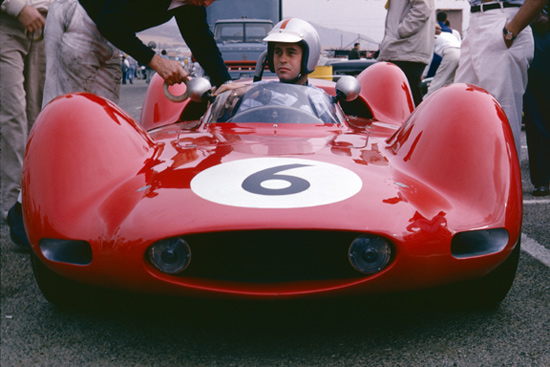 Penske in the Zerex Special in 1962. © Bob Tronolone "Roger was just a punk kid at the time but he knew how to get sponsors. He used to say he would get the name on the car but if it was a small amount of money the smaller the ad on the car would be. The bigger the money, the bigger the size of the name on the car would be. He said I'll make it so big they can see it in the grandstand. Back then you weren't allowed to run advertising on the cars by the SCCA but Roger made it happen. "In 1961 Walt Hansgen was driving a brand new Cooper F1 car at Watkins Glen and he wrecked it. Penske bought that car and it became the Zerex Special. I put that car together. I didn't do the body or the paint work. Bob Webb and Harry Ditmarsh did the body and I put it together at my little shop." After running the Zerex for Penske at the end of 1962 and winning at Riverside and Laguna Seca, Gane went to work for John Mecom for a few years before joining Penske Racing to run the Trans-Am team. He also worked on various other Penske cars but was an independent-minded fellow who preferred to go his own way. Today, at 88, Gane says his goal is to outlive RP! Don Cox was Penske Racing's first and only engineer from 1969-'76. Cox started his career as an engineer in Chevrolet's R&D department in Detroit. He graduated from the General Motors Institute and worked for Chevrolet on the Chaparral project from 1966-'68 before joining Penske. "I worked in the race shop from late 1969 through 1976," Cox recalls. "In those days I was back and forth between all the projects Roger was running--the Trans-Am cars, the Indy cars, the Ferrari Le Mans car, the Porsche Can-Am cars and anything else Roger wanted me to work on." Cox and Mark Donohue designed Penske Racing's first custom made shop when the team moved from Newtown Square to Reading in 1973. "We built a 10,000 square foot shop and by the time they left in 2006 it was about 40,000 square feet," Cox remarks. "The place they're in now in Mooresville occupies 300,000 square feet!"  Don Cox, Earle Macmullen and Kainhofer. © Kainhofer collection "Somewhere along the way Roger decided he wanted a dyno room as part of the complex so I acted as the general contractor building the dyno operation. Karl worked with me a little bit in the beginning welding up the base plate for the dyno but then he had to go to England to build the Formula 1 car. "We built the dyno room and all the control mechanisms and started building engines. When Karl came back from running the F1 team after Mark was killed he went to work in there for the next twenty years. "Back in the early and mid seventies," Cox adds, "we used to do fifty or sixty races a year and we did it with twelve or fifteen guys. It was a tough drill but that was the standard. Karl was always gung-ho and Mark was always gung-ho. That's the way it was. It was hard work but I wouldn't trade it for anything." After leaving the race team at the end of 1976 Cox went into business with Penske. "I got into the Detroit Diesel business in '76 and got a Diesel dealership in Philadelphia but I continued to go to the races until 1988. For many years I would be the engineer and strategy guy on the third car at the 500-mile races." Cox owned three Detroit Diesel dealerships in Pennsylvania, then became a trouble-shooter for Penske in a variety of dealerships and finally a one-third owner of Penske's Detroit Diesel business in Australia. Cox sold his interest and retired in 2002. John Woodard worked for Penske Racing from 1969-'76. Woodard was crew chief on Penske's Trans-Am cars and Porsche Can-Am cars. He also worked on Penske's early NASCAR cars and engines and assisted Karl at Indianapolis for a few years. "Late in 1971 I went to Weissach, Germany for six weeks to learn about the Porsche 917/10 Can-Am cars," Woodard relates. "I worked the Pocono and Ontario 500s that year but the rest of the year was totally the Porsche 917/10 Can-Am cars with Greg Syfert and Heinz Hofer. After Mark was injured in testing at Road Atlanta in June, Follmer took over and won the championship. In 1973 Mark dominated the Can-Am series with the 917/30. He won six of eight races and completed all but seven laps of the year. "It was almost a 24-7 job in those days. It was hard work, but everybody did it. Nobody put in more hours or worked harder than Mark Donohue. He was there when you got there and he was there when you left, and that cost him his marriage. 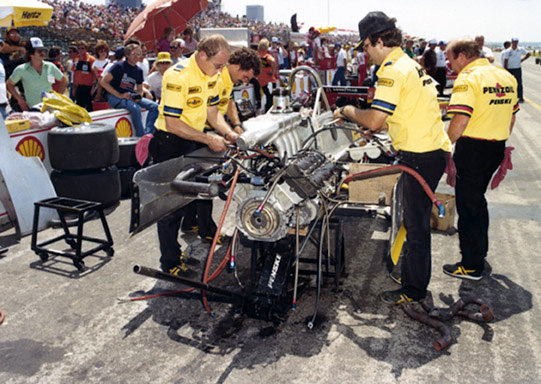 John Woodard at left at work in the pits 1983. © Racemaker/Dennis Torres Woodard then worked on Penske's first NASCAR program, building engines and working on the race team through 1976 before deciding to retire from racing. After leaving the team Woodard came back as a weekend warrior from 1978-'89 changing the right rear tires for the likes of Bobby Unser, Al Unser and Danny Sullivan. "In 1978, Roger asked me to come back as a weekend warrior and change the right rear tire on Indy cars. I did Bobby Unser's win at Indy in 1981, Danny Sullivan's 'spin and win' in 1985, and Al Unser Sr.'s fourth win in 1987. At the end of the 1989 season, I retired from anymore racing activities." Woodard began his post-racing life working for one of Penske's Detroit Diesel dealerships rebuilding diesel-powered generators. In 1980 Penske moved him to Cincinnati where Woodard worked as head of parts and world service for a few years. Next came a tenure back in Reading first as the district manager, then vice-president of Penske Truck Leasing. In 1992 Penske formed a new company to re-manufacture diesel engine parts. He put Woodard in charge of the operation which included four plants around the country. Penske asked Woodard to consolidate the four plants into one, giant operation employing more than 400 people which he did before retiring in 2002. Today, Woodard and his wife Susan live in Weems, Virgina on a tributary of Chesapeake Bay and he maintains a shop where he restores cars and engines. Earle Macmullan joined Penske Racing in 1969, originally working on the Trans-Am team. Earle worked on Trans-Am, Can-Am and Indy cars and went on to become the team's transmission expert building gearboxes for the team's Can-Am Porsche 917/10s and 917/30s and Indy cars. Macmullan retired in 1998 after thirty years with Penske. He was married to Jean Macmullan who was Penske Racing's secretary from 1980-2000. Following a long illness Earle passed away in August last year. "Earle was an excellent all-round mechanic and fabricator," Kainhofer says. "He could do pretty much anything and do it better than most guys. He was an independent guy who did things his way, but that was the right way and it was the only way he was going to do the job. "One time, Earle decided he had enough of management telling him what to do and he said he quit. He left the building and I had to go after him and convince him to come back to work. It took a little doing, but that was Earle. He was a good guy and one of the key guys in the team for thirty years."  Earle Macmullan © Gary Gold "We tried to build as much as possible in-house to control the quality and the time frame," Goozee recalls. "We used to try to build a car on a three-week turnaround, and if you consider the complexity of an Indy car from those days, that was a lot of work to be done in a fairly short period of time. So it had to be very well-organized. We didn't rely on subcontractors except for gearbox machining and some of the smaller components. "We worked 13 hours a day, five days a week, and nine hours on Saturday. We tried to keep Sunday as near sacred as possible so everybody had an off day. We had an extremely good workforce. One of the beauties about Penske Cars was that people who worked there were employed as much for attitude and sense of commitment as for their capabilities. A company is only as good as its staff and Penske Cars was good at its job because of its excellent staff. "Because Roger is a businessman we ran the company as tightly as we could. There was not any fat anywhere. We controlled things very carefully. Roger sometimes set extremely difficult deadlines, but when the impossible had been achieved with his influence and insistence forcing you to overcome all difficulties there was a refreshing feeling that you had achieved something that had been superhuman and impossible. "He had a saying, 'Don't regard it as a challenge. It's an opportunity.' And that's very true. The corporate motto is, 'Effort equals results', and I used that phrase every day with my staff. It's something Roger generated and it's very true. It may sound a little glib to some people, but it is without doubt, a very true fact." Jay Signore raced an Elva Courier with Mark Donohue in 1959 and went on to work for Penske for 30 years. He and his wife Barbara were co-managers of Penske Racing from 1974-'80 and Signore was the boss of the IROC series for most of its life from 1974-2007. "I first met Roger when Mark and I were doing SCCA club racing with Elva Couriers," Signore says. "Roger was racing his RSK Porsches and other cars at the time. Maybe ten years later Mark had won the Can-Am championship and Roger was getting involved in power boat racing. He asked me to look at his boat and I flew down and took a look at his boat in Kissimee, Florida. Roger came to New Jersey for a race and we helped him with the boat and after the race he asked me to take the boat to Fond du Lac in Wisconsin for the next race, so I worked with him that summer on his boat. "At the end of the summer I told him I had to leave to go back to work and he asked me what kind of job I had that allowed me to be off working on boats in the summer. At the time, I was teaching school and when I told him he said he wanted me to go to work for him. 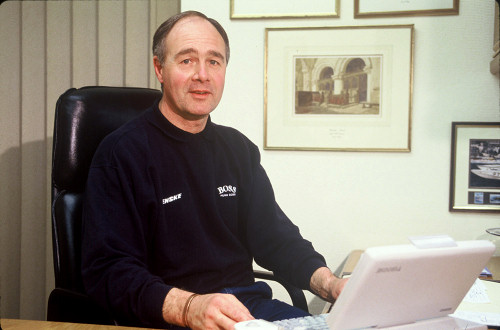 Nick Goozee © Gary Gold "We ran the IROC series for more than 30 years but the sport outgrew IROC. In the early days we had all the top drivers from Formula 1, Indy cars, NASCAR and sports car racing. It was a lot of fun for quite a few years but then each form of racing became more specialized and there was less and less room for any cross-over. The price of eggs grew higher and higher, and we just got priced out of the business. We closed the IROC operation in 2007. "Back in my early days with Penske Racing it didn't take a lot to manage the shop because guys like Karl, John Woodard and Earle Macmullan did their jobs so completely. I had to work with them on budgeting and schedules to make sure they had the things they needed to win races. "The neat part about working at Penske Racing through all the years was there were zero problems with managing people. Working with the crew chiefs and getting the teams working together well was a real team effort. Guys would cross over from one car to another to help out and everyone worked together. "I never considered having to deal with people as a major issue because everyone was committed in the same way to the team effort. Everyone worked together and saw what each other was doing and there was similarity in the preparation of the cars. "In the early days we didn't have a lot of engineers like we have today. The sport itself has grown by leaps and bounds and you have to stay up with the times and move forward. But those were great days. I really have fond memories of those years." Jerry Breon joined Penske Racing in 1974 and was the team's chief fabricator for many years. Following Karl's retirement and after more than twenty years on the road with the race team Breon became Penske's facilities manager at the end of 1997. When Penske moved his team to North Carolina in 2006 Breon took on a similar job at the giant Team Penske complex in North Carolina. Breon retired in December of last year after more than 40 years with the team. Breon studied mechanical engineering in college and worked in the summers with Warren Agor's team helping build and race Agor's Trans-Am and Can-Am cars. After completing his education he got a job at Penske Racing working on the IROC cars.  © Dave Freidman/Penske Restoration Breon worked on the NASCAR team for three and half years through 1977 then joined the Indy car team. He worked on Tom Sneva's car in 1978, Bobby Unser's cars from 1979-'81, then spent ten years working on Rick Mears's cars. Breon also worked on Al Unser's cars when Big Al substituted for Mears in 1985 when Mears was injured. After Mears retired Breon worked on Al Jr.'s cars and finally Paul Tracy's cars so he enjoyed many race wins, Indy 500 victories and championships before deciding in 1996 to get off the road and become a shop-based guy. Breon recalls that when he joined Penske Racing in 1974 there were just thirteen employees. "There was a tremendous amount of accountability because when I started there were only about 13 of us in total, including Donohue and Roger," Breon says. "Everybody did everything. That's the way it had to be to get the job done. We would work all day and then get in the truck and drive all night. It's the same for every fledgling racer and race team, but it certainly gave me an appreciation of what it took to win. "Looking from the outside I always thought Penske Racing won because they had more money, better equipment and a better driver, but once I got inside I saw it was the amount of work that went into it and the attention to detail and the accountability. It was everybody working together toward the same goal. That was the key to winning races more than the dollars. "What kept me going for so long was the fortunate experience of going from the small Penske Racing to the big Team Penske of today and understanding that the core necessity hasn't changed regardless of how big we've become. As Roger has always said, 'Effort equals results'." Derrick Walker joined Penske Racing from Brabham at the end of 1975 to work on the Formula 1 team. He ran the F1 team through 1976 then worked at Penske Cars in the UK building Indy cars for a few years before moving to the United States to become Penske's Indy car team manager from the end of 1980-'88. Walker then joined Porsche's new Indy car team and started his own team in 1992. He ran his own team in CART and then IRL/IndyCar before working for IndyCar from 2013-'15 as the organization's technical and operations director. Today, Walker is the SCCA's director of pro racing. "Going to Penske was a move forward for me," Walker recalls. "But you soon got the message that Roger and Karl's way was the way it was going to be. Roger and Karl's perfectionist thing began to work its way into the best Formula 1 teams and other top teams around the world. It's not just about the polish. It's about having it right and always staying on top of it. You don't let it fall away. You always maintain the same level in the preparation of the cars and everything else. It's infectious. 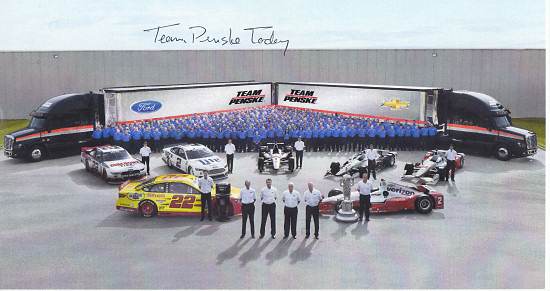 © Penske Racing "At the end of 1980 Jim McGee decided to leave Penske to go join his old friend Pat Patrick and Roger asked me if I wanted to take over McGee's job running the race team. So I took over that job and when I came over to Reading I got more involved with Karl. "In those days he ran a very tight ship in the engine shop. It was very organized and really the model for the race shop. The standard that went on in the engine shop percolated through the rest of the shop. That was really Roger and Karl's standard. "He was a stickler for details in very much the German way and that's the hallmark of what Penske Racing is today, very much so. I wasn't there in the Donohue days, but I'm sure he was a perfectionist just like Roger and Karl. The three of them were all that way and that's what Penske Racing became. "These days there are a lot of imitators because it is a sign of quality and perfection. It's almost like people do it because that's the way Roger does it but in those days he was the only guy who did it that way. A lot of people weren't even close to that. "Roger and Karl were well ahead of their time. It was second nature for Karl. It was part of the way he grew up and learned as a kid and an apprentice mechanic in Austria. He was a workaholic. When the work had to be done, he was there to do it. He was very much old school. 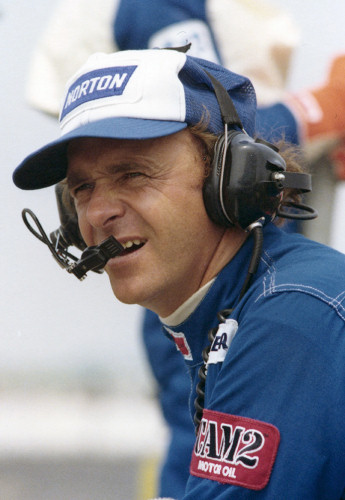 Derrick Walker © Racemaker/Dennis Torres Many others have contributed a great deal to Penske Racing's growth and development. Norman Ahn worked with Karl in the 1966 Can-Am series, designed the original Penske Racing logo, and went on to run Competition Tire and act as a key business consultant for Penske as well as building the California and Nazareth Speedways. Geoff Ferris designed the Penske F1 cars and early Indy cars from the PC5 through the PC12, helping establish Penske as a car builder. Nigel Bennett took over from Ferris and designed a long string of superb and very successful Indy cars from 1988-'97. Don Miller bounced back from suffering life-threatening injuries suffered in a pitlane accident at Talladega in 1974 to build Penske's modern NASCAR team in North Carolina in partnership with Rusty Wallace. Chuck Sprague took over Penske's team management duties from Derrick Walker in 1988 and guided the team through the end of the nineties. Clive Howell joined Penske Cars in 1979 and became a race mechanic the following year. Howell continues with Penske's IndyCar team in 2016 as a veteran overseer, strategist and operations manager. Nick Goozee says Howell is Team Penske's ramrod. And of course there's Tim Cindric who presided over the team's move ten years ago from Pennsylvania to North Carolina and is President of today's Team Penske. As Karl Kainhofer says, Penske Racing has come a long way from the tiny, two-man shop in Newtown Square where it all started 50 years ago to today's giant 300,000 square foot Team Penske operation in Mooresville, NC employing more than 400 people. |
|
Auto Racing ~ Gordon Kirby
Copyright ~ All Rights Reserved |
